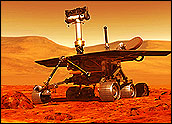
NASA’s rovers keep rolling toward fresh discoveries.
The Mars Exploration Rover Opportunity has found an iron meteorite, the first meteorite ever identified on another planet, according to officials with the Jet Propulsion Laboratory (JPL) in Pasadena.
Spectrometers on Opportunity determined that the object, about the size of a basketball, is composed mostly of iron and nickel. Only a small fraction of the meteorites that fall to Earth are similarly rich in metals; most are rockier.
“This is a huge surprise, though maybe it shouldn’t have been,” said Dr. Steve Squyres of Cornell University, principal investigator with the rover mission, in a JPL statement.
Erosion Clues
The meteorite has been named “Heat Shield Rock” because it sits near debris of Opportunity’s heat shield on the surface of Meridiani Planum, a flat region on the planet.
“I never thought we would get to use our instruments on a rock from someplace other than Mars,” Squyres said. “Think about where an iron meteorite comes from: a destroyed planet or planetesimal that was big enough to differentiate into a metallic core and a rocky mantle.”
According to Squyres, “Mars should be hit by a lot more rocky meteorites than iron meteorites.” He plans to have the rovers look for more meteorites in coming weeks.
“The key is not what we’ll learn about meteorites — we have lots of meteorites on Earth — but what the meteorites can tell us about Meridiani Planum,” he said. The number of exposed meteorites could be an indication of whether the plain is eroding away or being built up.
Long Mission
Opportunity and Spirit completed their primary three-month missions in April 2004. NASA has extended their missions twice because the rovers have remained in good condition. They have found evidence of past wet environmental conditions that might have been hospitable to life.
Opportunity has driven a total of 2.10 kilometers (1.30 miles). The rover team plans to begin driving Opportunity south toward a circular feature called “Vostok” within about a week.
Spirit has driven a total of 4.05 kilometers (2.52 miles). It has been making slow progress uphill toward a ridge on “Husband Hill” inside Gusev Crater.

















































